Special articles, columns and features exclusive to the MDb.
Samus Aran: The Woman Behind the Visor
A Critcal Theory Essay on the First Woman of Gaming
by Infinity's End
DISCLAIMER: THE FOLLOWING IS A PERSONAL, OPINIONATED PIECE AND DOES NOT NECESSSARILY REPRESENT THOSE OF THE METROID DATABASE STAFF. --IE
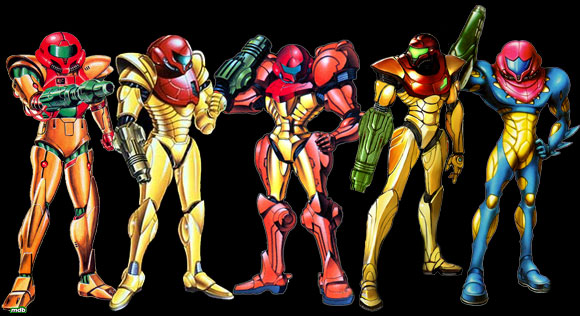
The Suit
At first glance, the Power suit may seem alien in origin or very nonstandard to common military body armor, but in reality, it is actually just a stylized, oversimplification of the human muscle structure. This can be seen especially in the ribcage area, her upper arms, her inner thighs, and calves. When taken in this regard, the Power suit is much less complicated than what is seen at a glance. This section will delve into the theories and explainations regarding Samus's amazing armored suit.
When Samus was first depicted as a 3 color, 32-pixel-high sprite, it left much to the imagination. In fact, it left everything to the imagination. Samus's original sprite is so arbitrary that the only details you can make out are a rather large red helmet, a green arm cannon, and red shoes. Like Mario, one wonders if Samus was created to fit the standards of the hardware, and then illustrating the concept art after the sprite was already conceived, instead of the other way around like the games of today.
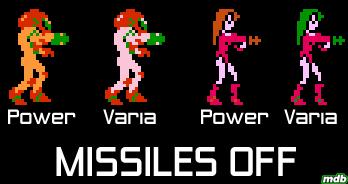 In the original, Samus changes colors to let the player know that her secondary weapon - missiles -
has been turned on. A palette swap is a fairly effective device in letting you know that your player
has changed in a drastic way and is still used in modern game design. Starting with Metroid II,
however, Samus gained more detail all around, so her missile hatch could be individually animated. The
visual feedback isn't nearly as drastic, but as was standardized in Super Metroid, we can now
rely on looking at the game HUD to tell us when we change weapons. Another amazing detail first depicted
in Metroid II was the fact that she had two destinct sides -- left and right -- depending on the
way she was facing. It is possible that Samus was the first asymmetrical game sprite ever featured in a
video game.
In the original, Samus changes colors to let the player know that her secondary weapon - missiles -
has been turned on. A palette swap is a fairly effective device in letting you know that your player
has changed in a drastic way and is still used in modern game design. Starting with Metroid II,
however, Samus gained more detail all around, so her missile hatch could be individually animated. The
visual feedback isn't nearly as drastic, but as was standardized in Super Metroid, we can now
rely on looking at the game HUD to tell us when we change weapons. Another amazing detail first depicted
in Metroid II was the fact that she had two destinct sides -- left and right -- depending on the
way she was facing. It is possible that Samus was the first asymmetrical game sprite ever featured in a
video game.
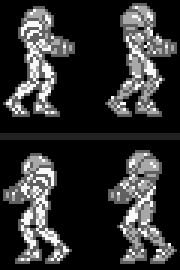 Though it was originally designed as predominantly masculine, the Power suit has gone through many distinct
design changes throughout the years since Hiroji Kiyotake's first version in 1986. We already know about
the manual's masculine pronouns and describing "him" as a cyborg with cybernetic enhancements. Judging from
the original concept art, the design of the original suit was obviously made to reflect this, as can be seen
via various tubes protruding from the suit's arms. The rest of the suit portrays a very mechanical, robotic,
and blocky design that reflects contemporary sci-fi conventions of the mid-1980's. In fact, one could even
point out that Samus's original design was not that strong or memorable. But that was soon to change...
Though it was originally designed as predominantly masculine, the Power suit has gone through many distinct
design changes throughout the years since Hiroji Kiyotake's first version in 1986. We already know about
the manual's masculine pronouns and describing "him" as a cyborg with cybernetic enhancements. Judging from
the original concept art, the design of the original suit was obviously made to reflect this, as can be seen
via various tubes protruding from the suit's arms. The rest of the suit portrays a very mechanical, robotic,
and blocky design that reflects contemporary sci-fi conventions of the mid-1980's. In fact, one could even
point out that Samus's original design was not that strong or memorable. But that was soon to change...
When Metroid II: Return of Samus was released for the Game Boy in 1991, Samus's armor upgrade could no longer be shown with color, resulting in a graphic redesign to the suit. The finished product came closer to how we now see Samus, and the upgrade to her Varia suit would mean she would now gain very large shoulderpads instead of turning pink as in the original. The new suit also featured a more streamlined helmet and arm cannon, and supremely more curvaceous features. The design change was drastic enough for Nintendo to also change the box art for NES Metroid, for those that may have never played the original. The "Yellow Box" reissue of the game featured the new Samus prominently on the cover, in her now infamous "kneeling with hand on arm cannon" pose.
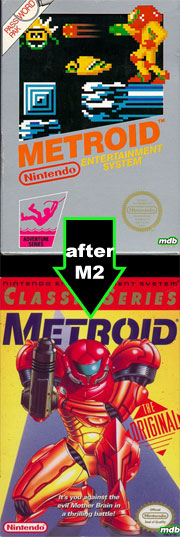 Varia, the suit which protects Samus from extreme heat, is another unusual word, but not quite made up.
This word actually comes from a romanization of how a Japanese speaker would pronounce the English word "barrier."
The katakana (Japanese characters that are usually used for non-Japanese words) for barrier is ba-ri-a pronounced
"bah-ree-ah." Furthermore, there is no distinction between the pronunciation of b and v in the
Japanese language, so the v was used in the translation and the word "varia" was invented. You can even see
barrier being used on this page of the
official Japanese Metroid II site.
Varia, the suit which protects Samus from extreme heat, is another unusual word, but not quite made up.
This word actually comes from a romanization of how a Japanese speaker would pronounce the English word "barrier."
The katakana (Japanese characters that are usually used for non-Japanese words) for barrier is ba-ri-a pronounced
"bah-ree-ah." Furthermore, there is no distinction between the pronunciation of b and v in the
Japanese language, so the v was used in the translation and the word "varia" was invented. You can even see
barrier being used on this page of the
official Japanese Metroid II site.
Granted, it is also certainly possible that whoever localized Metroid knew it should have been barrier and thought it would be more interesting to invent a new word. Since I haven't played any Japanese versions, I cannot comment if NOJ has ever decided to use the word Varia for pertaining to this suit, but I would assume they would still use the katakana since it would have the same "spelling" regardless of which word they were using.
Though Samus's armor went through a design change with Return of Samus, it went through another slight refinement with the next installment in the series, Super Metroid. Her waist was made thinner, her chest was shoved out distinctly, and her pelvis was made more defined. For a time, this look became what most people think of when they depict Samus. The suit design is very curvy, and seems much more feminine than the two prior, more masculine suits. This design also seems to be the main inspiration for the model used in the GameCube game, Super Smash Bros. Melee.
As many hardcore fans of the series know, 1994 through 2002 marked the drought of Metroid games. The only way one could still control Samus was through her appearances in the Super Smash Bros. series. So when Metroid Prime was released, the Power suit underwent another distinct design change as Samus ascended into the third dimension. Concept artist Andrew Jones took figure drawings of women and placed Samus's armor on top, to make sure it would fit with a female form. Through this, the inspiring concept art lent the Power suit to achieve a much more feminine look, but still retains the core shape of the previous iterations. The suit still looks agile and strong, and overall empowering to the body wearing it. Though there was a design decision to overemphasize the Varia shoulder pads, the Power suit's overall shape made an almost perfect translation to 3D, and even with new lights added to the suit, the Varia has become the standard look of Samus Aran. The new look has also carried into her recent iteration in Super Smash Bros. Brawl, which seems to be a combination of the designs from of Super and Prime.
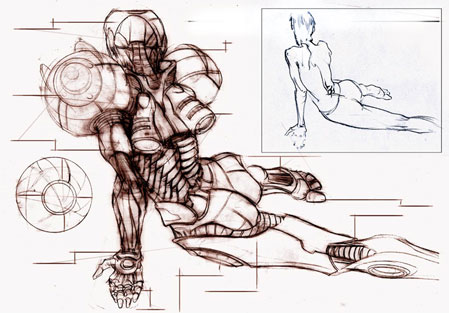
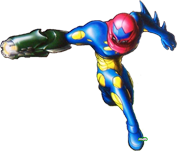 In Fusion, due to the story calling for the Power suit to become surgically removed from Samus's body, the suit
made its 5th design change. The Fusion suit is even moreso like an extension of the human muscle structure in that it
almost seems skin tight to Samus's body. In addition to a complete overhaul of the basic design structure of the Power
suit - including removal of the shoulder pads - the arm cannon and helmet were also given drastic redesigns. The overall
body structure also seems to downplay a feminine form, as her chest and hips do not seem to be accentuated in any way -
harkening back to a much more masculine frame.
In Fusion, due to the story calling for the Power suit to become surgically removed from Samus's body, the suit
made its 5th design change. The Fusion suit is even moreso like an extension of the human muscle structure in that it
almost seems skin tight to Samus's body. In addition to a complete overhaul of the basic design structure of the Power
suit - including removal of the shoulder pads - the arm cannon and helmet were also given drastic redesigns. The overall
body structure also seems to downplay a feminine form, as her chest and hips do not seem to be accentuated in any way -
harkening back to a much more masculine frame.
Many fans have mixed feelings about the Fusion suit. Since it is unknown at this time if we'll ever see another official 2D Metroid game again, whether or not the Fusion suit will carry on with her is also unknown, but one thing's for sure, there would have to be a major plot device created that would allow her to regain her old Power suit look. Otherwise, we may never stop seeing prequels for Metroid if they want to keep Samus in her standard suit.










